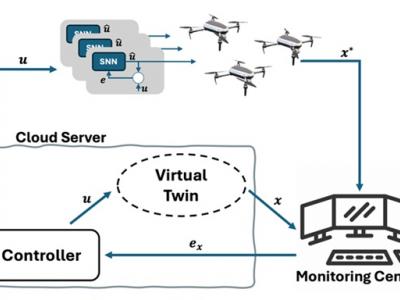*.M (Matlab)
Presented study introduces a novel distributed cloud-edge framework for autonomous multi-UAV systems that combines the computational efficiency of neuromorphic computing with nature-inspired control strategies. The proposed architecture equips each UAV with an individual Spiking Neural Network (SNN) that learns to reproduce optimal control signals generated by a cloud-based controller, enabling robust operation even during communication interruptions.
- Categories:
 205 Views
205 ViewsThe Kirk circle is a simple and effective method for representing power graphs and visualizing their topology. In general, nodes (buses) in an electrical network are numbered with neighboring nodes assigned consecutive or closely proximal numbers. This allows for sequential mapping of these nodes in increasing order of their numerical labels to evenly spread points on a Kirk circle. In the Kirk circle, the edge connections (branches) between nodes are indicated by straight lines (chords) between the appropriate points on the circle.
- Categories:
 196 Views
196 Views
This is a MATLAB code and data for the work [1].
"code" folder includes MATLAB codes.
Requirements: Control System Toolbox, Parallel Computing Toolbox, cvx
"data" folder includes the data described in the manuscript.
[1] Hampei Sasahara, "Adversarial Destabilization Attacks to Direct Data-driven Control," submitted to IEEE OJ-CSYS, 2023.
- Categories:
 103 Views
103 Views
A novel two-dimensional (2-D) direction finding method is proposed and verified based on a 4-element time modulated circular array (TMCA). The received signals of four antenna elements are input to the single channel in turns. After the periodical modulation, the azimuth and elevation angles can be estimated simultaneously through analyzing the spectrum characteristic of the received signal. The proposed direction finding method has simple structure and concise signal processing.
- Categories:
 138 Views
138 Views
This dataset is made for traditional, machine learning, and deep neural-network-based virtual sensor development and evaluation.
- Categories:
 95 Views
95 Views
Two Matlab scripts are presented.
code1.m : This Matlab script solves the signal design problem (P2) as described in the paper: B. Dulek and S. Gezici, "Optimal Signal Design for Coherent Detection of Binary Signals in Gaussian Noise under Power and Secrecy Constraints". It relates to the simulation depicted in Section IV - Figure 1.
- Categories:
 140 Views
140 ViewsOral health problems are closely associated with the analysis of dental tissue changes and the stomatologic treatment that follows. The associated paper explores the use of diffuse reflectance spectroscopy in the detection of dental tissue disorders. The data set includes 78 out of 343 measurements of teeth spectra in the wavelength range from 400 to 1700 nm. The proposed methodology focuses on computational and statistical methods and the use of these methods for the classification of dental tissue into two classes (healthy and unhealthy) by estimating the probability of class membership.
- Categories:
 293 Views
293 ViewsAnthropometric studies focusing on facial metrics and their proportions form an important research area devoted to observations of the appearance of the human skull. Many different applications include the use of craniometry for maxillofacial reconstruction and surgery. The paper and the associated dataset explores the possibility of using selected craniometric points and associated metric to observe spatial changes during the maxillofacial surgery treatment. The experimental dataset includes observations of 27 individuals.
- Categories:
 235 Views
235 Views


